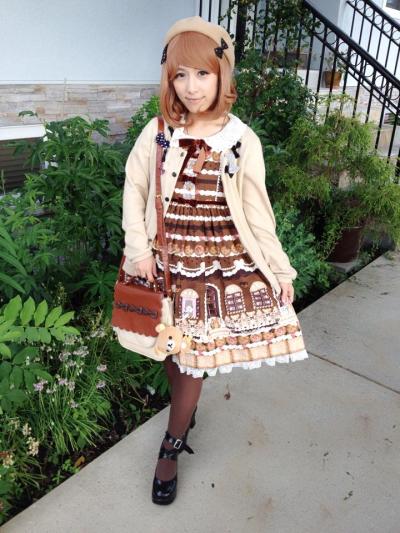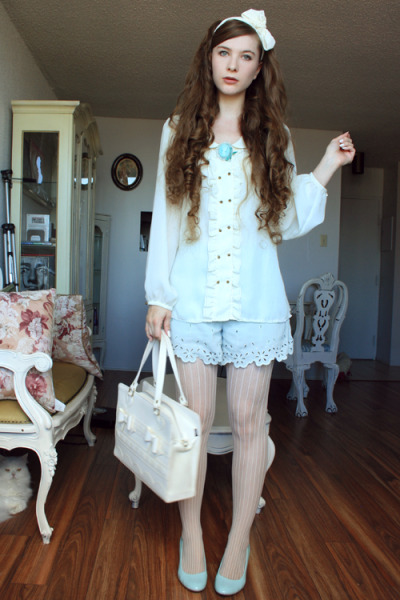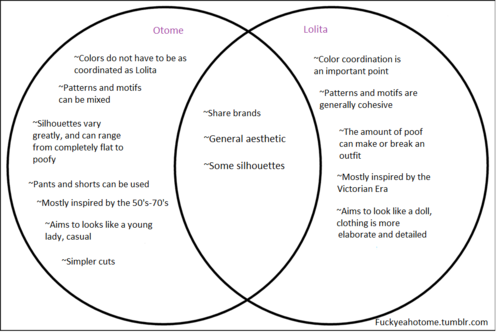Previously I've introduced you to underrated/unknown (life)styles like Mori and MODE-kei, as well as lesser understood ones such as Dansou, but this time I'm going to be passing the spotlight to a predecessor style that even most of its Lolita descendants have never heard of!
The Beginning of Otome
 |
| Note: Simple large print; minimal accessories & longer cut than most Lolita dresses |
Otome-kei is a style that began to emerge in post-war Japan and reached the high of its popularity in the 70s-80s. Nowadays you may often see some Otome coords confused with Casual Lolita, or hear Otome-kei referred to as 'the Lolita of the 1980s', and this wouldn't be too far off because Otome is actually the style from which Lolita was born.
Modern Day OtomeWhile Otome used to take most of its influence from the 50s-70s, nowadays there are many looks that fit within the 'Otome umbrella.' Otome-kei is still popular in Japan to this day but is quite unknown in the foreign J-fashion community, especially outside outside the Lolita community.
What really makes Otome hard to understand (and sets it apart from its descendant Lolita) is that the style is very 'free' rather than having a strict set of rules. Some of the most popular characteristics are:
 |
| Note: Bold colours; simple, large but mixed prints & few accessories (also bare legs - uncommon in Lolita) |
- bold colours
- large but simple prints (especially when compared to Lolita)
- ruffles & ribbons
- embroidered details
That said, an Otome coord can feature any number of these characteristics, a mixture of one of these characteristics, or none at all. Otome is a style that focuses a lot more on the feeling it gives its wearers than the clothes they are actually wearing: do you feel like a young lady? Feminine, elegant, modest? If so, then its most likely you're wearing it right. Of course, a little coordinate is a necessity, but nothing beats that natural lady-like instinct!
Otome vs Lolita
 |
| Simplistic Lolita coordi that would fit perfectly into the Otome style |
First and foremost, it's important to understand that a lot of Casual Lolita coords ARE Otome coords, which is why a lot of Lolita wear Otome on their off days, but not a lot of Otome coords can be classified as Lolita. This is because, while lots of Otome brands do release dresses that can be used in Lolita (and vice verse) there are a number of fundamental differences:
- Silhouettes
Lolita has a set number of silhouettes that are suitable for the style and a petticoat is a necessity, however in Otome, no such rule exists: one's skirt/dress can be as flat or as puffy as they like.
- Prints
 |
| Note: SHORTS, simplistic accessories, no prints, but still has an elegant feeling |
- Accessorising, Motifs & Colour-Ways
Another big difference is how each style accessorises and matches pieces. In Lolita you will often find a motif, for examples chocolate, reflected in both their prints and their numerous accessories. A Lolita will also try to stick to a specific colour-way (theme) for their entire outfit. In Otome however, there can be as much or as little accessorising as you want, though it often tends to be simpler than Lolita and motifs/colour-ways are less coordinated and can be mixed within one outfit.
Some Otome coords can also be described as a more mature version of Lolita; once you have a proper understanding of either style, it is usually easier to tell the difference. Oh, and I almost forgot to mention the biggest difference: in Otome it is totally acceptable to wear shorts and trousers (pants) too!
If you're still confused, here is a helpful chart:
My Style:: The Beginning of A JourneyNow, I do not know if Otome has a male version, but I'm going to pass this section along to Harmony since she is the one this section really concerns:
(Harmony) Okay, I don't want to steal Hanzel's thunder so I'm going to keep this short and sweet! For those of you who read our blog or watch our videos you probably already know everything about why I'm starting my journey into Otome-kei.
I'm still relatively new to the community and I just did my first haul of Otome style clothes, so its still too soon for me to give you definitive information on my style. However, as I know there's a lot of you out there who have never heard of this style and would like to start on this journey with me, I've decided to write a short blog series documenting my experiences as I start into this style, and sharing with you the little pearls of wisdom I gain along the way, hopefully helping you with your journey too!
I haven't figured out all the details just yet and there's still a lot of information I need to collect, but hopefully I'll be able to make your journey easier in some way, shape or form~ There's no definite date just yet, but the series will most likely begin in early 2016. When I've put together all my plans, I'll post an introductory post to the series for you guys, so be sure to keep your eyes peeled! (^o^)/
Here ends my introduction to Otome-kei, unfortunately there was a lot I wasn't able to cover in this post, but hopefully through Harmony's upcoming series you'll be able to learn a lot more. If you have any questions or points you'd like her to focus on, be sure to leave a comment and let her know, and hopefully you can all enjoy your journey into this style together.




No comments:
Post a Comment